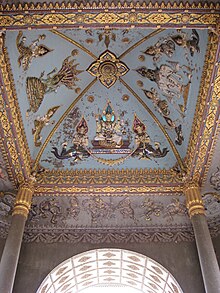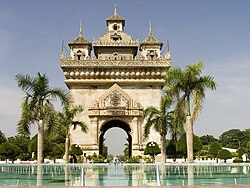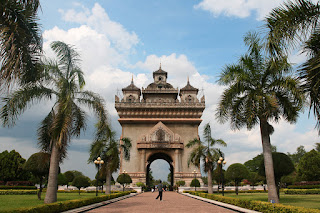Patuxai Arch, Vientiane, Laos.
ประตูชัย (ประตูไซ) นครหลวงเวียงจันทร์ สาธารณรัฐประชาธิปไตยประชาชนลาว.
Patuxai Arch, Vientiane, Laos.
Photo Gallery. Asian Historical Architecture.
ขอบคุณ ภาพและข้อมูล
จาก http://www.orientalarchitecture.com/sid/457/laos/vientiane/patuxai-arch
Patuxai Arch (1960)
The Patuxai, The Arch or Gate of Triumph, is reminescent of the Arc de Triomphe of Paris—large scale and with a single arch with an observation deck on top. It was built to commemorate Lao who had died in battle serving their country before the revolutionary wars. It was begun in 1960 an completed with concrete donated by the United States for the construction of the airport.
As with its Parisian counterpart, there is a broad processional avenue leading to it and a series of roads radiating out from it. Up close one can see the various Lao motifs and designs.The upper part is uniquely Lao.
Text by Robert D. Fiala.
Location
The approximate location of the site is 17.970631' N, 102.618690' E (WGS 84 map datum).
01.Patuxai Arch, Vientiane, Laos. Photo Gallery. Asian Historical Architecture.
ประตูชัย (ประตูไซ) นครหลวงเวียงจันทร์ สาธารณรัฐประชาธิปไตยประชาชนลาว.
ประตูชัย (ประตูไซ) นครหลวงเวียงจันทร์ สาธารณรัฐประชาธิปไตยประชาชนลาว.
02..Patuxai Arch, Vientiane, Laos. Photo Gallery. Asian Historical Architecture.
ประตูชัย (ประตูไซ) นครหลวงเวียงจันทร์ สาธารณรัฐประชาธิปไตยประชาชนลาว.
ประตูชัย (ประตูไซ) นครหลวงเวียงจันทร์ สาธารณรัฐประชาธิปไตยประชาชนลาว.
03..Patuxai Arch, Vientiane, Laos. Photo Gallery. Asian Historical Architecture.
ประตูชัย (ประตูไซ) นครหลวงเวียงจันทร์ สาธารณรัฐประชาธิปไตยประชาชนลาว.
ประตูชัย (ประตูไซ) นครหลวงเวียงจันทร์ สาธารณรัฐประชาธิปไตยประชาชนลาว.
04..Patuxai Arch, Vientiane, Laos. Photo Gallery. Asian Historical Architecture.
ประตูชัย (ประตูไซ) นครหลวงเวียงจันทร์ สาธารณรัฐประชาธิปไตยประชาชนลาว.
ประตูชัย (ประตูไซ) นครหลวงเวียงจันทร์ สาธารณรัฐประชาธิปไตยประชาชนลาว.
05..Patuxai Arch, Vientiane, Laos. Photo Gallery. Asian Historical Architecture.
ประตูชัย (ประตูไซ) นครหลวงเวียงจันทร์ สาธารณรัฐประชาธิปไตยประชาชนลาว.
ประตูชัย (ประตูไซ) นครหลวงเวียงจันทร์ สาธารณรัฐประชาธิปไตยประชาชนลาว.
06..Patuxai Arch, Vientiane, Laos. Photo Gallery. Asian Historical Architecture.
ประตูชัย (ประตูไซ) นครหลวงเวียงจันทร์ สาธารณรัฐประชาธิปไตยประชาชนลาว.
ประตูชัย (ประตูไซ) นครหลวงเวียงจันทร์ สาธารณรัฐประชาธิปไตยประชาชนลาว.
07..Patuxai Arch, Vientiane, Laos. Photo Gallery. Asian Historical Architecture.
ประตูชัย (ประตูไซ) นครหลวงเวียงจันทร์ สาธารณรัฐประชาธิปไตยประชาชนลาว.
ประตูชัย (ประตูไซ) นครหลวงเวียงจันทร์ สาธารณรัฐประชาธิปไตยประชาชนลาว.
08..Patuxai Arch, Vientiane, Laos. Photo Gallery. Asian Historical Architecture.
ประตูชัย (ประตูไซ) นครหลวงเวียงจันทร์ สาธารณรัฐประชาธิปไตยประชาชนลาว.
ประตูชัย (ประตูไซ) นครหลวงเวียงจันทร์ สาธารณรัฐประชาธิปไตยประชาชนลาว.
09..Patuxai Arch, Vientiane, Laos. Photo Gallery. Asian Historical Architecture.
ประตูชัย (ประตูไซ) นครหลวงเวียงจันทร์ สาธารณรัฐประชาธิปไตยประชาชนลาว.
-----------------------------------------------------------
จาก https://en.wikipedia.org/wiki/Patuxai
Patuxai
From Wikipedia, the free encyclopedia

 02.
02.
History.
ประตูชัย (ประตูไซ) นครหลวงเวียงจันทร์ สาธารณรัฐประชาธิปไตยประชาชนลาว.
Patuxai Arch, Vientiane, Laos.
Photo Gallery. Asian Historical Architecture.
ขอบคุณ ภาพและข้อมูล
จาก http://www.orientalarchitecture.com/sid/457/laos/vientiane/patuxai-arch
จาก https://en.wikipedia.org/wiki/Patuxai
Patuxai
From Wikipedia, the free encyclopedia

01.
ประตูไซกับลานแสดงน้ำพุประกอบดนตรี
| ||
| ข้อมูล | ||
|---|---|---|
| ที่ตั้ง | เวียงจันทน์ ลาว | |
| สถานะ | เสร็จแต่ไม่สมบูรณ์ | |
| เริ่มก่อสร้าง | ค.ศ. 1957 | |
| แล้วเสร็จ | ค.ศ. 1968 | |
| รายละเอียด | ||
| จำนวนชั้น | 7 ชั้น | |
| มูลค่า | 63 ล้านกีบ | |
| บริษัท | ||
| สถาปนิก | Tham Sayasthsena[ต้องการตรวจสอบความถูกต้อง] | |
| เจ้าของ | รัฐบาลลาว | |
Patuxai (Lao: ປະຕູໄຊ, literally meaning Victory Gate or Gate of Triumph, formerly the Anousavary or Anosavari Monument, known by the French as Monument Aux Morts) is a war monument in the centre of Vientiane, Laos, which was built between 1957 and 1968. The Patuxai is dedicated to those who fought in the struggle for independence from France. In romanising the name from the Laotian language, it is variously transliterated as Patuxai, Patuxay, Patousai and Patusai. It is also called Patuxai Arch or the Arc de Triomphe of Vientiane as it resembles the Arc de Triomphe in Paris. However, it is typically Laotian in design, decorated with mythological creatures such as the kinnari (half-female, half-bird).

| Location within Laos | |
| Former names | Anousavary |
|---|---|
| General information | |
| Type | War Memorial |
| Architectural style | Laotian |
| Location | Vientiane, Laos |
| Address | Lang Xang Avenue |
| Coordinates | 17°58′14″N102°37′07″E |
| Construction started | 1957 |
| Completed | 1968 |
| Inaugurated | 2010 (450th anniversary of Vientiane as capital of Laos) |
| Cost | 63 million kips |
| Client | Laos |
| Owner | Government of Laos |
| Technical details | |
| Structural system | Concrete |
| Floor count | Seven |
| Design and construction | |
| Architect | Mr. Tom Le Anh Quan |
History.
Patuxai is a compound word, 'Patuu' or 'patu' meaning a "door" or "gateway" and 'Xai', derivative of the Sanskrit 'Jaya', which means "victory". Thus it means “Victory Gate”.[3][7] The Patuxai was built during a turbulent period Lao history. It was built when Laos was a constitutional monarchy and was originally known simply as the "Anousavali" ("memory"), dedicated memory of the Laotian soldiers who died during World War II and the independence war from France in 1949.
The monument was built using American funds and cement actually intended to build a new airport.[8] The Royal Laotian Government instead built the monument, which earned it the nickname of the "vertical runway".[3][4]
The monument was designed by Tham Sayasthsena, a Laotian architect. In 1957, his plans were selected out of those submitted by the Public Works Department, the Military Engineering Department, and numerous private architects. Tham received 30,000 kips for his work. The cost of construction was estimated as 63 million kips.[1]
In May 1975, the communist Pathet Lao overthrew the coalition government and seized power, ending the ancient monarchy and installing a half-Vietnamese prime minister. They renamed the monument Patuxai in honor of their own victory.
Geography[edit]
The Patuxai is at the end of Lang Xang Avenue in the heart of Vientiane. Patuxay Park surrounds the monument
Architecture[edit]
The monument has five towers that represent the five principles of coexistence among nations of the world. They are also representative of the five Buddhist principles of “thoughtful amiability, flexibility, honesty, honor and prosperity”.[1]
The monument, as built, has gateways on four sides oriented towards the four cardinal directions. The East-West gateways open to the Long Xang Avenue, which is used during ceremonial national parades. In front of each gate, there is a pond. The four ponds represent the open section of a lotus flower (representing reverence of Laotians to the brave warriors of the nation). The four corners of the gateways are adorned by statues of a Naga King (mythical symbol of Laos), with a depiction signifying spraying of a jet of water (suggesting nature, fertility, welfare and happiness) into the ponds on the ground.[1] Two concrete staircases wind up from inside the main structure, passing through each floor, right up to the top of the monument. Viewing galleries are provided on the upper floors. The first floor has mainly the offices of the management of the monument; the kiosks dealing with tourist paraphernalia (artefacts, souvenirs and refreshments) are also housed on this floor. The second floor is an important area where a museum is housed, displaying statues and pictures of the iconic heroes and heroines of the country.
The next level is an open space where four towers are built at the four corners. These towers have been decorated with frescoes of foliage. The towers are also fitted with electric lights, which are switched on during the national day and other important festivals. The small towers, with temple like ornamentation, are designed in the Laotian style and are provided with spires. Each tower has a stairway. Apart from the four corner towers, there is another central larger tower above this floor, which also has a staircase which leads to the top floor that has the viewing platform from where a panoramic view of Vientiane could be seen. A telescope is also fitted at that level to get a view of the city. Plans have been drawn to fit lifts from two diagonal corners of the monument, which are expected to be ready in 2010 when the 450th anniversary of Vientiane as the capital of Laos will be celebrated. On this occasion, the entire monument is proposed to be decorated with flowers and illuminated.[1] The monumental building is not fully finished to this day, although the Laotian government have repeatedly authorized new funds.[8]
The musical fountain system fitted in the newly developed elegant garden was donated by the Chinese. It is a popular feature for visitors and local people who visit the monuments in the afternoons
Full view of the Patuxai
---------------------------------------------------------------------------------------------
จาก https://th.wikipedia.org/wiki/ประตูไซ.
ปะตูไซ
จากวิกิพีเดีย สารานุกรมเสรี
สำหรับความหมายอื่น ดูที่ ประตูชัย
| ปะตูไซ ປະຕູໄຊ | ||
|
ประตูไซกับลานแสดงน้ำพุประกอบดนตรี
| ||
| ข้อมูล | ||
|---|---|---|
| ที่ตั้ง | เวียงจันทน์ ลาว | |
| สถานะ | เสร็จแต่ไม่สมบูรณ์ | |
| เริ่มก่อสร้าง | ค.ศ. 1957 | |
| แล้วเสร็จ | ค.ศ. 1968 | |
| รายละเอียด | ||
| จำนวนชั้น | 7 ชั้น | |
| มูลค่า | 63 ล้านกีบ | |
| บริษัท | ||
| สถาปนิก | Tham Sayasthsena[ต้องการตรวจสอบความถูกต้อง] | |
| เจ้าของ | รัฐบาลลาว | |
ปะตูไซ (ลาว: ປະຕູໄຊ; ในอดีตเรียกว่า "อะนุสาวะลี") เป็นอนุสรณ์สถานตั้งอยู่ท้ายสุดทางทิศตะวันออกเฉียงเหนือของถนนล้านช้างใจกลางนครเวียงจันทน์ ประเทศลาว ก่อสร้างในระหว่างปี ค.ศ. 1957 ถึงปี ค.ศ. 1968[ต้องการตรวจสอบความถูกต้อง] เพื่อเป็นการสดุดีวีรชนผู้ร่วมรบเพื่อประกาศเอกราชจากประเทศฝรั่งเศส ปะตูไซถูกตกแต่งด้วยศิลปะแบบล้านช้าง นำสัตว์ในตำนานตามความเชื่อของศาสนาพุทธ เช่น กินรี และพญานาค เป็นต้น และเทพเจ้าในศาสนาพราหมณ์-ฮินดู มาตกแต่ง บริเวณโดยรอบมีลานจัดการแสดงน้ำพุประกอบดนตรีและสวนปะตูไซ
ประวัติ[แก้]
ชื่อเรียก[แก้]
ปะตูไซ เป็นคำประสมมาจากคำว่า "ปะตู" (ປະຕູ) หมายถึง "ประตู" และ "ไซ" (ໄຊ) มาจากภาษาสันสกฤตคำว่า "ชะยะ" หมายถึง "ความชนะ" ความหมายของคำจึงเหมือนเช่นเดียวกับคำว่า "ประตูชัย" ในภาษาไทย ส่วนการถอดเป็นอักษรโรมันของคำว่า ปะตูไซ นั้นมีหลายรูปแบบ ได้แก่ Patuxai, Patuxay, Patousai และ Patusai[1]
หลังจากประตูไซสร้างเสร็จ เป็นช่วงที่ลาวมีการปกครองแบบราชาธิปไตยภายใต้รัฐธรรมนูญ สถานที่นี้ถูกรู้จักกันในชื่อ "อะนุสาวะลี" (ອານຸສາວະລີ) ซึ่งหมายถึง "ความทรงจำ" เนื่องจากเป็นอนุสรณ์สถานสำหรับการสดุดีวีรชนจากการประกาศเอกราช[2] ต่อมาในปี ค.ศ. 1975 ขบวนการปฏิวัติฝ่ายคอมมิวนิสต์ปะเทดลาว ยึดอำนาจรัฐบาลได้เด็ดขาดและพระมหากษัตริย์สละราชสมบัติ ทำให้เปลี่ยนการปกครองจากแบบเดิมเป็นสังคมนิยมคอมมิวนิสต์ จึงเปลี่ยนชื่ออะนุสาวะลีเป็น "ปะตูไซ" (ປະຕູໄຊ) เพื่อเป็นเกียรติแก่ชัยชนะของคณะปฏิวัติ จนใช้เรียกกันถึงปัจจุบัน[3] นอกจากนี้ปะตูไซยังถูกเรียกว่าเป็นอาร์กเดอทรียงฟ์แห่งเวียงจันทน์ เนื่องจากมีลักษณะคล้ายกับอาร์กเดอทรียงฟ์เดอเลตวล ในปารีส ประเทศฝรั่งเศส[1] และมีชื่อเล่นเรียกว่า "รันเวย์แนวตั้ง" เพราะใช้ปูนซิเมนต์สำหรับสร้างสนามบิน[4]
การก่อสร้าง[แก้]
ประตูไซสร้างขึ้นเพื่อเป็นอนุสรณ์สถานสำหรับสดุดีแก่ทหารลาวที่เสียชีวิตในระหว่างการกอบกู้เอกราชจากประเทศฝรั่งเศสในสงครามโลกครั้งที่สอง[2] ถูกออกแบบโดย Tham Sayasthsena สถาปนิกชาวลาว ในปี ค.ศ. 1957 แบบของเขาได้รับเลือกจากกรมโยธาธิการ กรมวิศวกรการทหาร และสถาปนิกเอกชนอีกจำนวนมาก โดย Tham ได้รับเงินค่าตอบแทนเป็นจำนวน 30,000 กีบสำหรับงานออกแบบของเขา วัสดุที่ใช้ก่อสร้างเป็นปูนซิเมนต์จากประเทศสหรัฐอเมริกาที่ไว้ใช่สำหรับสร้างสนามบินใหม่ในเวียงจันทน์ แต่รัฐบาลลาวในสมัยนั้นนำมาใช้ในการสร้างปะตูไซแทน[4] ปะตูไซหยุดการสร้างในปี ค.ศ. 1968 แต่ไม่ได้สร้างเสร็จสมบูรณ์ตามแบบที่ออกแบบไว้ในตอนแรก เพราะสถานการณ์บ้านเมืองที่ผ่านมาปั่นป่วน รวมมูลค่าทั้งหมดประมาณ 63 ล้านกีบ
หนึ่งในสี่ป้อมบนชั้นบนสุดของปะตูไซ
มุมมองแบบเต็มของตัวปะตูไซ
น้ำพุหลังปะตูไซขณะทำการแสดงน้ำพุประกอบดนตรี
สวนปะตูไซเมื่อมองลงมากจากบนสุดของปะตูไซ
ภายในของปะตูไซมีการตกแต่งด้วยเทพเจ้าในศาสนาพราหมณ์-ฮินดู
---------------------------------------------------------
จาก http://www.bloggang.com/mainblog.php?id=moonfleet&month=06-11-2014&group=258&gblog=84
จาก http://www.bloggang.com/mainblog.php?id=moonfleet&month=06-11-2014&group=258&gblog=84
25.08.2557 คณะฯThai UNRI มาเยือนประตูชัย นครหลวงเวียงจันทร์ สาธารณรัฐประชาธิปไตยประชาชนลาว.
1.คณะฯ Thai UNRI ได้มาเยือนประตูชัย นครหลวงเวียงจันทร์ สาธารณรัฐประชาธิปไตยประชาชนลาว.
2. คณะฯ Thai UNRI ได้มาเยือนประตูชัย นครหลวงเวียงจันทร์ สาธารณรัฐประชาธิปไตยประชาชนลาว.
3. คณะฯ Thai UNRI ได้มาเยือนประตูชัย นครหลวงเวียงจันทร์ สาธารณรัฐประชาธิปไตยประชาชนลาว.
4. คณะฯ Thai UNRI ได้มาเยือนประตูชัย นครหลวงเวียงจันทร์ สาธารณรัฐประชาธิปไตยประชาชนลาว.
5. คณะฯ Thai UNRI ได้มาเยือนประตูชัย นครหลวงเวียงจันทร์ สาธารณรัฐประชาธิปไตยประชาชนลาว.
6. คณะฯ Thai UNRI ได้มาเยือนประตูชัย นครหลวงเวียงจันทร์ สาธารณรัฐประชาธิปไตยประชาชนลาว.
7. คณะฯ Thai UNRI ได้มาเยือนประตูชัย นครหลวงเวียงจันทร์ สาธารณรัฐประชาธิปไตยประชาชนลาว.
8.คณะฯ Thai UNRI ได้มาเยือนประตูชัย นครหลวงเวียงจันทร์ สาธารณรัฐประชาธิปไตยประชาชนลาว.
----------------------------------------------------------





























ไม่มีความคิดเห็น:
แสดงความคิดเห็น